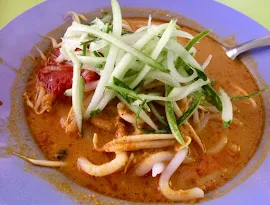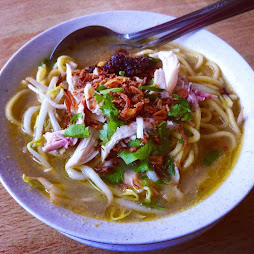Laksa - unique noodle dish with Persian twist
Laksa is a popular spicy and tasty noodle dish that originated from the Peranakan, descendents from the early Chinese immigrant who married local Malay women thus gave rise to the fusion of flavours from the ingredients used. This dish is very popular with both Chinese and Malay alike, and of course to the many tourists or visitors to this island who have got hooked on it.
The laksa noodle is the thick rice noodle type. The laksa curry is a rich spicy coconut-based noodles soup, the ingredients which may include bean sprouts, tofu (taupok), cockles, slices of chicken and egg. It is usually topped with a spoonful of sambal belacan, a fermented shrimp and chilli paste, and laksa leaf for the added zest.
The Malays call laksa leaf daun kesum rather than daun laksa. Daun means leaf. Cockles' laksa is the more common type of laksa but there are other options such as those containing prawns or pieces of chicken for those who are allergic to seafood. Laksa leaf is a herb which is an intrinsic part of this dish. It has a strong flavour just like curry leaf. In Vietnam and in Thailand, laksa leaf is eaten raw as salad.
There are variants of laksa such as asam or Penanag laksa. Penang is a state in northern Malaysia, with quite a high concentration of Chinese and Peranakan.
 |
| Curry Laksa |
The Malays call laksa leaf daun kesum rather than daun laksa. Daun means leaf. Cockles' laksa is the more common type of laksa but there are other options such as those containing prawns or pieces of chicken for those who are allergic to seafood. Laksa leaf is a herb which is an intrinsic part of this dish. It has a strong flavour just like curry leaf. In Vietnam and in Thailand, laksa leaf is eaten raw as salad.
 |
| Laksa Siglap at Bedok Corner |
Asam or Penang laksa is sourish fish-based noodle soup that usually contains slices of cucumber, pineapple, onions, mint, galangal, chili, lemongrass, dried lime leaves (kaffir lime leaves), and the bunga kantan or torch ginger bud for the distinctive fragrant and taste.
Galangal is a ginger-family spice that can be found in many Asian curries and soups as it has warm, earthy taste with citrusy tang. But for Penang asam laksa, its main distinguishing ingredient is asam or tamarind which gives it a fishy-sourish taste. The fish is usually mackerel or ikan kembung in Malay.
You can get a bowl of laksa for about $5 at many hawker centres and food-courts. You ca also find laksa at some chain food outlets such as at Qi Ji. Some visitors flock to Katong to get their fix of laksa. Posters of popular celebrity chefs like Gordon Ramsey are plastered on walls of some of the laksa outlets in Katong along East Coast Road. Katong is a Peranakan enclave.
A favourite laksa include laksa Siglap at Bedok Corner. Siglap is a precinct in the eastern part of Singapore, not that far from Katong. Maybe the original stall was from Siglap, hence the name. When people have the chance to go to Penang, Malaysia, asam or Penang laksa is a must have dish there. Incidentally the word laksa means noodle or vermicelli in Persian. A yummy uniquely local dish with a Persian twist perhaps.
If you are at Bedok Corner do check out Laksamana stall as this stall sells different types of laksa such as the Singapore laksa, laksa Johor and Penang asam laksa. They even have a storyboard to show these different types of laksa at the stall. Very educational indeed. Many visitors or tourists buy pre-packed laksa paste, that they can bring back home as souvenirs to remind them how tasty this dish is.
There are also laksa instant noodles sold in many supermarkets here, some of whom work together with speciality laksa cafe such as the popular 328 Katong Laksa, thus carrying its brand.
Do you know that daun kesum (laksa leaf) grows in the wild in ditches and banks of ponds and streams? It can grow easily in a pot too. So this humble herb indeed brightens the traditional tasty dish without it there will be no laksa!
Galangal is a ginger-family spice that can be found in many Asian curries and soups as it has warm, earthy taste with citrusy tang. But for Penang asam laksa, its main distinguishing ingredient is asam or tamarind which gives it a fishy-sourish taste. The fish is usually mackerel or ikan kembung in Malay.
 |
| Galangal and tamarind |
You can get a bowl of laksa for about $5 at many hawker centres and food-courts. You ca also find laksa at some chain food outlets such as at Qi Ji. Some visitors flock to Katong to get their fix of laksa. Posters of popular celebrity chefs like Gordon Ramsey are plastered on walls of some of the laksa outlets in Katong along East Coast Road. Katong is a Peranakan enclave.
A favourite laksa include laksa Siglap at Bedok Corner. Siglap is a precinct in the eastern part of Singapore, not that far from Katong. Maybe the original stall was from Siglap, hence the name. When people have the chance to go to Penang, Malaysia, asam or Penang laksa is a must have dish there. Incidentally the word laksa means noodle or vermicelli in Persian. A yummy uniquely local dish with a Persian twist perhaps.
If you are at Bedok Corner do check out Laksamana stall as this stall sells different types of laksa such as the Singapore laksa, laksa Johor and Penang asam laksa. They even have a storyboard to show these different types of laksa at the stall. Very educational indeed. Many visitors or tourists buy pre-packed laksa paste, that they can bring back home as souvenirs to remind them how tasty this dish is.
 |
| Wild daun kesum (laksa leaf) |
Do you know that daun kesum (laksa leaf) grows in the wild in ditches and banks of ponds and streams? It can grow easily in a pot too. So this humble herb indeed brightens the traditional tasty dish without it there will be no laksa!



Comments
Post a Comment